JACKIE BROWN
NOT JUST A THEATRE ORGANIST
-oOo-
JACKIE AT FARFISA ORGANS (1965-1969)
 Jackie seated at a Farfisa 6050 Organ
Jackie seated at a Farfisa 6050 Organ
Jackie playing Carmenita on this Organ (from the album Farfisa Romantica)
-oOo-

The Electric/Electronic Organ is an Electronic Keyboard instrument which was derived from the Harmonium, Pipe Organ and Theatre Organ. (Definition obtained from Wikipedia.)
Over the years, this type of Organ has evolved into several types of instruments including those used as home and exhibition organs, as well as those used in Combos.
-oOo-
The following comments were provided by the organist, Mr. Keith Beckingham, and relate to the Electronic Organ market in the UK and offer an explanation as to why these instruments proved to be so popular with the public.

Keith Beckingham
-oOo-

A number of Companies found success in the production of such instruments, and include those discussed below. Please note that this collection is by no means complete:
THE HAMMOND ORGAN COMPANY (1935-1985): It is believed that the Company produced at least two-million instruments, thereby making it perhaps the most successful of such companies. The Hammond Organ may be heard in a variety of music genres including Jazz, Gospel and Pop & Rock Music. Ethel Smith (1902-1996) was one of the first musicians to employ a Hammond Organ and became known as the First Lady of the Hammond Organ, and during the 1950s, Jimmy Smith (1925-2005) popularised the instrument in Jazz circles. The musician Booker T. Jones (1944), who together with The MGs, is considered a conduit from Rhythm ‘n’ Blues to Rock Music and inspired others to employ the instrument.
-oOo-
Walk on the Wild Side, Part 2 (1962) performed by Jimmy Smith
Green Onions (1962) performed by Booker T & The MGs employing the Hammond M3 Organ
A Whiter Shade of Pale (1967) performed by Procol Harum
(with Matthew Fisher playing the Hammond M-102 Organ)
-oOo-
KEITH BECKINGHAM notes that It needs to be remembered that prior to the huge number of appearances made by Electronic Organs in Jazz and Pop Groups that in the UK, Hammond Organs provided entertainment at Holiday Camps, Summer Shows and TV Shows such as Lunch Box and a number of Quiz Shows where artists such as Robin Richmond (1912-1998), Harold Smart (1921-1980), Jerry Allen (1925-1985) etc etc. were featured.
-oOo-
THE LOWREY ORGAN COMPANY (1918-1989): The Lowrey Organ Company‘s first commercially successful full-sized electronic organ, the Model S Spinet or Berkshire, was first marketed in 1955. In the 1960s and 1970s. The Company was the largest manufacturer of electronic organs in the world, and in 1989, produced its millionth instrument and, unlike reval companies, always relied on electronic tone generation for their products. In 1988, The Company was purchased by Kawai Musical Instruments, which in 2018, announced that The Lowrey Organ Company would stop production.
 Lowrey TBO Berkshire Organ (1966)
Lowrey TBO Berkshire Organ (1966)
Lowrey Electronic Organs were often employed by a number of popular music artists. The Beatles employed a number of electronic organs, including one produced by Lowrey during the recording of For the Benefit of Mr. Kite, which appeared on the album, Sgt. Pepper’s Lonely Hearts Club Band, in order to help create the sound of a Merry-Go-Round, and again on the track, Lucy in the Sky with Diamonds. The musician and songwriter, Mike Oldfield (1953) used a Lowrey Electronic Organ to help create the sounds heard in his album, Tubular Bells.
A short excerpt of Tubular Bells, Parts 1, performed by Mike Oldfield
-oOo-
 The final model bearing the name Lowrey, The EX6500P Aria Pro
The final model bearing the name Lowrey, The EX6500P Aria Pro
-oOo-
THE VOX CONTINENTAL (1962-1971): The Vox Continental was first manufactured by the Jennings Musical Instruments factory in Dartford in Kent in 1962. Most of the components for the organ were subcontracted to other companies, with Jennings working on the final assembly. It quickly became popular, as it was advertised as part of the British Invasion of the US in the mid-1960s, particularly after being endorsed by The Beatles. In 1966, in order to increase supply of the various instruments designed, the Organs began to be produced by the Thomas Organ Company in the US, and later in Italy. The Company eventually ran into problems and was liquidated in 1971. It is thought that approximately nine thousand instruments were sold.
 The Super Continental (1965)
The Super Continental (1965)
These instruments helped create the sounds of The British Invasion,
the Psychedelic–Summer of Love (1967) and much of the other popular music of the 1960s.
-oOo-
The House of The Rising Sun (1964) – Performed by The Animals
with Alan Price playing the Vox Continental Organ
-oOo-
THE YAMAHA CORPORATION ELECTONES: Electone is the Trademark used for those Electronic Organs manufactured by The Yamaha Corporation and were first introduced in 1959 with the D-1, an instrument intended for home use.
The design of most Electones was based on the Spinet. This term was coined by Laurens Hammond (1895-1973) when he introduced the Model M in 1948 and is defined as a Home Organ with short, staggered manuals of 37, 44 and 49 notes together with a short Pedalboard, usually of 13 notes. An Organ with a 61-note manual and a full Pedalboard of 25 or 32 notes, is known as a Console or Full Console model.
These instruments had simplified controls and functions that were cheaper to produce and less off-putting to learn. A feature on many of the Spinets was Single Finger Chords, which were introduced in the 1970s. Here a Chord (i.e. a group of three or more notes sounded together, as a basis of Harmony) and struck as a single key (i.e. Tonic Note) is usually used in conjunction with the organ’s Automatic Rhythm Unit to produce an accompaniment pattern over which the organist could play a melody on the upper manual.
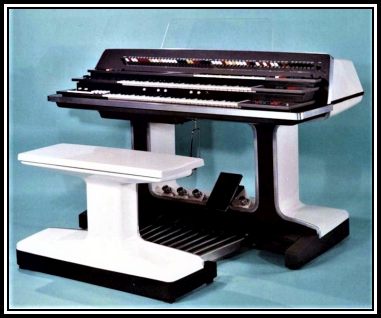 Yamaha Ex-42
Yamaha Ex-42
-oOo-
Andrew Gilbert at the Yamaha AR100 Organ playing Delicardo
-oOo-
To read more of the Electones in the UK, Click Here.
-oOo-
FARFISA: The Company was an electronic manufacturer that was formed in Osmio in Italy, following the merger of three Italian Accordion companies (Settimio Soprani, Scandalli and Fontalini) in 1946. The name, Farfisa, is a shortened version of its official name, Fabbriche Riunite Fisarmoniche Italian S.p.A., which translates into English as United Accordion Factories.
In the late 1950s, the Company started producing Combo Organs (i.e. a portable Electric Organ designed to be used by a musical Combo) in response to the success achieved by the Vox Continental instrument and continued to do so until the 1980s.
 Farfisa Combo Compact Duo (1966)
Farfisa Combo Compact Duo (1966)
-oOo-
Wooly Bully (1965) – Performed by Sam The Sham & The Pharaohs
featuring the Farfisa Combo Compact Duo
-oOo-
ANDREW GILBERT notes that the album, Farfisa Romantica, which Jackie made soon after joining Farfisa Organs, ‘and at that time, the Company was probably best known for its Combo and Stage Organs, such as the Compact Duo and the Fast, which had a biting, rather brittle sound.
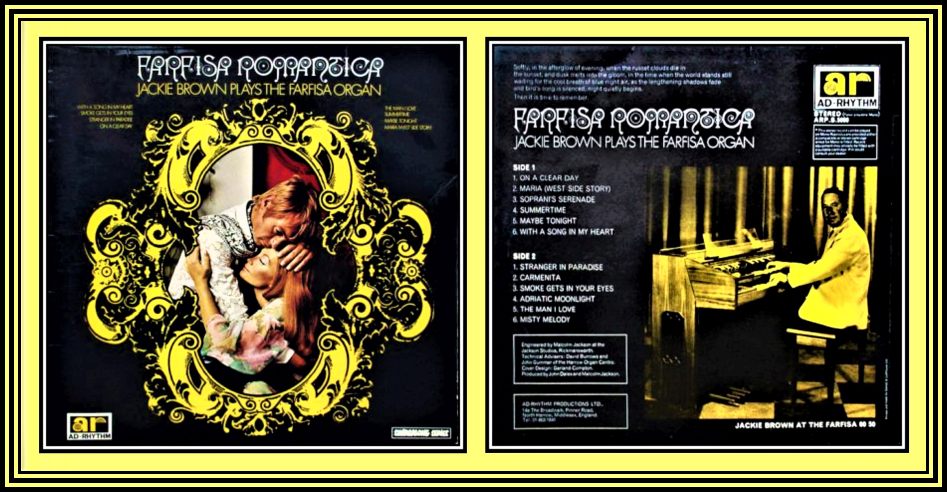
With the fast growing home organ market in the late 1960s, I suspect Farfisa wanted to show off some gentler sounds and Jackie certainly delivered that with this album. The overall tone of the Model 6050 used is still a bit shrill – all Italian organs were like that at this time – but clever use of Registrations allowed Jackie to convey the mixture of old standards and original compositions with a sound rather different to the Stage models.
Jackie playing, Stranger in Paradise from the album, Farfisa Romantica
-oOo-

 Jackie’s daughters, Amanda (seated) & Julie
Jackie’s daughters, Amanda (seated) & Julie
AMANDA CERRETTINI-BROWN, the eldest of Jackie’s daughters, remembers the time when her father was associated with Farfisa Organs and offers her memories here:

-oOo-
KEITH BECKINGHAM adds: The Head of Farfisa UK was Mr. Dickie Wren who I knew well from the time we had worked together at Boosey and Hawkes. Mr. Wren was a great admirer of Jackie’s playing, dating back to the period when Jackie played the Hammond Organ on the BBC’s Morning Music Programme and was keen to get him on board as a Company Promotional Artist. He also realised that it was important to have a well-regarded musician, such as Jackie, as an endorsee for Farfisa Organs. While with the Company, Jackie worked alongside Graeme Wright, another well-respected musician.
-oOo-
Amanda continues:

-oOo-
Amanda continues:
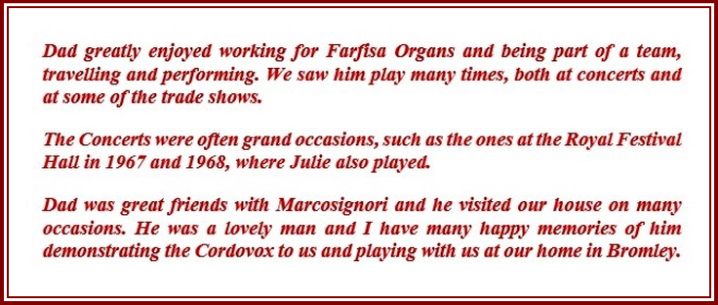
Amanda Cerrettini-Brown
-oOo-

 Marcosignori, also known as The Poet of The Accordion
Marcosignori, also known as The Poet of The Accordion
Marcosignori was born Gervasio Marcosignori (1927-2013) in Castelfidardo in the Province of Ancona and studied the accordion with his father, Giovanni. In 1934, when he was 7-years old, he played before Benito Mussolini (1883-1945), and later before Queen Elizabeth II (1926) and Pope John Paul II (1920-2005) amongst other dignitaries. He earned the nickname Poet of the Accordion and was awarded the World Oscar by the CMA for his international contribution to the accordion.
Marcosignori playing a George Gershwin (1898-1937) medley
In 1962, he began working with Farfisa Organs to develop the Cordovox, an electronic accordion, and continued to work with them performing concerts, demonstrations and acting as consultant until 1984.
-oOo-
 A Gift of Sheet Music to Jackie from Marcosignoiri of a piece written by him
A Gift of Sheet Music to Jackie from Marcosignoiri of a piece written by him
-oOo-

Part of Jackie’s duties while associated with Farfisa Organs was to travel to various regions of the country, often in the company of other Farfisa associates, to demonstrate Company products at concerts and Trade Fairs.
One of the first such Demonstrations/Concerts was held at the Fulham Town Hall in London on the 23rd February, 1966. The event, or Swingalong with Farfisa, as it was officially titled, was sponsored by the Western Music Company Limited, which operated a large musical merchandise store in the area.
 A poster to advertise a Farfisa Demonstration/Concert in 1966
A poster to advertise a Farfisa Demonstration/Concert in 1966
-oOo-
An example of another of the many Demonstrations/Concerts given was at the Keiby Hotel in Burnley on 25th March, 1968.
 The Farfisa Team dressed in Company Jackets
The Farfisa Team dressed in Company Jackets
From left to right: Mrs Pollard, Mr E. C. Wren (Managing Director of Farfisa Organs UK), Messrs James and Thomas Pollard, Jackie, John Dales and Marcosignori at a Concert/Demonstration given
at the Keiby Hotel in Burnley on 25th March, 1968.
This Demonstration/Concert was organised by Pollards of Burnley in conjunction with Farfisa Organs.
 Jackie being introduced by Dickie Wren at this Demonstration/Concert
Jackie being introduced by Dickie Wren at this Demonstration/Concert
-oOo-

Mr. Ernest Cranfield Wren (1914-1980), the Managing Director of Farfisa Organs UK). was better known as Dickie to his friends. He was always referred to by this nickname, which was a name given to him by his school friends because of his surname, Wren, Dickie Bird! Seemingly, he used to occasionally receive mail addressed to Mr. Richard Wren!
KEITH BECKINGHAM adds: I first got to know Dickie Wren in the early 1960’s when he joined me at Boosey and Hawkes at its Regent Street branch as a Hammond Organ Sales Representative. Dickie and I worked together on various Hammond promotions including exhibitions in Brighton and Eastbourne.
Dickie later joined Selmer in Charing Cross Road, which at that time were importers and distributors of Lowrey Organs. Selmer was a shop which was very much a part of London’s music scene for many years and was renown as being where many famous guitarists bought instruments.
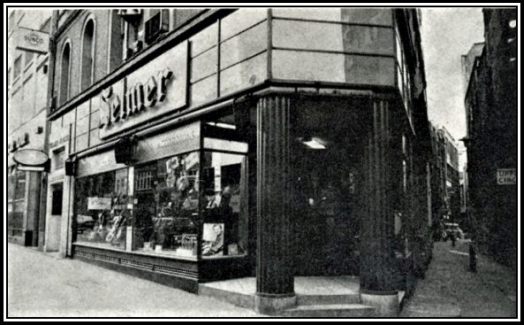 Selmer of London
Selmer of London
From Selmer, Dickie joined the J. Arthur Rank Organisation who were diversifying at the time into other non-film/cinema activities. Rank became the UK distributors of Farfisa Organs and Dickie was employed in view of his experience in this field. However it was not long before Farfisa decided to set up their own sales and distribution operations. Dickie was offered a position with Farfisa, which he accepted, and was appointed Managing Director. The new company, Farfisa UK, was established in Gainsborough in Lincolnshire and Dickie and his family lived nearby in the small village of Scotter.
It was whilst staying with Dickie and his family one week-end in Scotter that I mentioned that Hammond were setting up a new operation in Milton Keynes. This evidently set Dickie thinking, and as Farfisa (UK) needed larger premises at this time, he re-located the company there soon after.
Dickie played a major role in the Electronic Keyboard and Organ Distributors Association (EKODA) to which all the major companies belonged. The association arranged an annual trade exhibition and worked together in the promotion of electronic organs and keyboards.
Dickie was well regarded by his many colleagues in the music trade.
-oOo-
Mr. Wren’s daughter, Tessa Brand, says that although her father was not a musician in the traditional sense, did play the piano and the organ. She adds that whilst he could read music, he was fairly proficient at playing by ear. He told her that he used to play the church organ in the chapel at school. When the teachers were walking in/out, he would play appropriate music. However, once they had left, he would break out into Boogie Woogie tunes, which his fellow pupils enjoyed very much! Mrs. Brand sent the following two photographs of her father and mother.
 Left: Mr. Wren’s wife, Joy (1932-1988) seated on a stool on the Queen Elizabeth 2;
Left: Mr. Wren’s wife, Joy (1932-1988) seated on a stool on the Queen Elizabeth 2;
Right: Mr. & Mrs. Wren (far right) at a function at the Imperial Hotel in Torquay in 1979
-oOo-

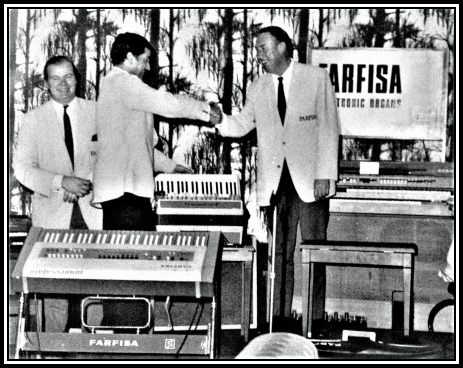 At a Trade Fair in 1968 with (from left to right) John Dales, Marcosignori & Jackie
At a Trade Fair in 1968 with (from left to right) John Dales, Marcosignori & Jackie
KEITH BECKINGHAM adds: I first met John Dales when I did a concert tour of South Africa in 1965 where I presented; a series of Hammond Organ Showcase Demonstration Concerts. He invited me to his parents palatial home where he had a Hammond A-100 Organ with customised speakers built into the wall. John was a largely a self-taught organist who played what I would describe as melodious jazz. He was a most likeable person with an infectious sense of humour and we developed a lasting friendship. John later joined Hammond Organ South Africa and I recall he visited the UK on one occasion from where we both flew to Chicago for the NAMM Trade Show. When John moved to the UK, he joined Farfisa Organs as a demonstrator. He was a very friendly person and got along well with Jackie, since without doubt, they would have found much in common musically. Ultimately John moved back to South Africa where he married his wife, Pru. The last time I saw him was when I went back in South Africa in the early 1980’s. John enjoyed the good things of life, perhaps a little too much, and it was sad that he died comparatively young.
-oOo-
 Jackie being introduced to the public at a Trade Fair in the early 1970s
Jackie being introduced to the public at a Trade Fair in the early 1970s
-oOo-
 Jackie & Marcosignori talking to their friend Stan, a customer, at a Trade Fair
Jackie & Marcosignori talking to their friend Stan, a customer, at a Trade Fair
-oOo-
 Marcosignori (left), Dickie Wren (second from the left) & Jackie (second from the right)
Marcosignori (left), Dickie Wren (second from the left) & Jackie (second from the right)
along with others at a Trade Fair
-oOo-
In only the third year of building Electronic Organs, Farfisa had produced more that 40,000 instruments.
-oOo-

In the early 1960s, the Hal Leonard Publishing Corporation in the U.S., produced a number of books for enthusiasts who owned a home electronic organs. During the boom years of home electronic organ sales, a number of organ manufacturing companies produced similar books. These books contained organ arrangements, which were produced by qualified musicians, such as Theatre Organists.
In the U.K., The Lawrence Wright Music Company Limited published a number of music books including some especially for those owning Hammond Organs. The Company also produced others and asked Jackie to provide the Introductions and to provide comments and notes on the Musical Arrangements included in the books. Jackie was an ideal candidate for such a position given his skills in both arranging and playing.
What follows is the Cover of the first Book of Organ Solos, the Introduction, a list of the Musical Arrangements and an example of one such arrangement:




Following is the Cover of the Second Book of Organ Solos, the Introduction, a list of the Musical Arrangements and an example of one such arrangement:



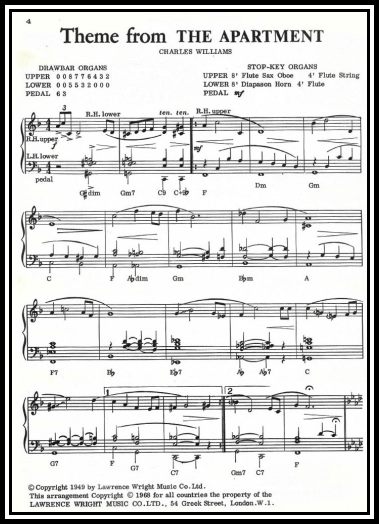
-oOo-
The organists, George Blackmore (1921-1994), Robin Richmond and Harold Smart, also helped produce similar books of Organ Solos.
-oOo-
 Jackie’s Wallet & Notebook while at Farfisa Organs
Jackie’s Wallet & Notebook while at Farfisa Organs
-oOo-
During Jackie’s time with Farfisa Organs, and thanks to the flexibility and generosity of Mr. Dickie Wren, the Managing Director of Farfisa Organs (UK), he was able to continue to play for fellow members of the Cinema Organ Society (COS) and the Theatre Organ Club (TOC) at their Sunday gatherings and also to record Theatre Organs for BBC Radio.
-oOo-
By the time Jackie joined, Farfisa Organs (UK), finding regular work on television and film was becoming scarce. In addition, the smaller music publishing firms were being swallowed up by larger companies and their were less and less opportunities open to Theatre and Electronic Organists. As a result, working for Farfisa Organs provided Jackie with a regular and reliable income, which would have been of importance since he now had a growing family to support by this time.
-oOo-
Jackie enjoyed working for Farfisa Organs (UK), and was sad to leave, but at the end of 1969, he was offered a opportunity to work with Southern Organs. The owners of the Company, Messrs. Jim Miller and John Bellord, had attended a Demonstration/Concert given by Farfisa associates and were so impressed with his abilities that they offered him the position of Musical Director of Southern Organs. And this was, as they say, an offer he could not refuse!
—oooOooo—
ACKNOWLEDGEMENTS
I would like to thank Mrs. Tessa Brand and Messrs Keith Beckingham, Andrew Gilbert and Michael Wooldridge for their contributions to the writing of this page.
—oooOooo—
—oooOooo—

